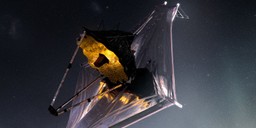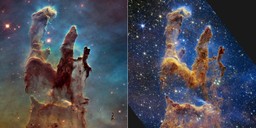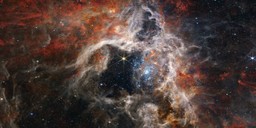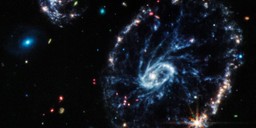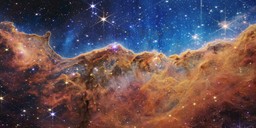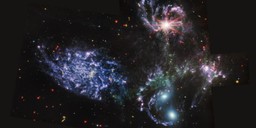Wei-Di Cheng ’93 showed an interest in space from a young age. Even so, he spent his first two years of university as an art major before his mother questioned his choice. “After my mom lectured me, saying, ‘There’s not much future in doing art.’ — that changed my path,” says Cheng. That lecture drew him back to what inspired him as a child and led him to UW–Madison’s engineering physics department. “There was a full NASA research lab, doing the composite material study, funded by NASA. ... I heard it was a great school to go to, and that brought me to the UW,” Cheng recalls. “I was intrigued by all the things I heard from the news, the things beyond [Earth], and what the future could hold.” Now, as a stress analyst in the Space Division at Northrop Grumman in Redondo Beach, California, Cheng has a hand in the space exploration efforts he admired as a kid — and gets to produce art as a result.
For the James Webb Space Telescope (JWST) project, the $10 billion successor to the Hubble Space Telescope, Cheng worked on the Mechanical Ground Equipment Testing Group. A major focus of this testing was packing the sunshield, a five-layer device designed, in part, to prevent heat and light from interfering with the telescope’s ability to capture infrared images.
Now, one million miles away from Earth, the JWST is sending back images that reveal previously unseen objects and help scientists discover the origins of the universe. “The experience of being an engineer is constant learning,” Cheng says. “[With] every project, I learn something new. It’s not repetitive, and to me, it’s not boring. It’s very challenging. It makes life, and a career in engineering, very satisfying for me.”
Keep scrolling to see a few of the images made possible by Cheng’s work. Image credits: NASA and the Space Telescope Science Institute.
James Webb Space Telescope
- An artist’s rendering shows the sunshield out in full force.
- 1 million miles from Earth
Pillars of Creation
- Images from the Hubble Telescope (left) in 2014 and the Webb Telescope (right) in 2022 showcase the power of new imaging technology.
- 6,500 light-years from Earth
Tarantula Nebula
- Thousands of never before seen stars are now visible, appearing in blue. Rust-colored gas tells astronomers about the hydrocarbons that form future stars.
- 159,800 light-years from Earth
Cartwheel Galaxy
- A group of galaxies that make up the Sculptor constellation, including the Cartwheel (right).
- 500 million light-years from Earth
Cosmic Cliffs
- The edge of a giant gaseous cavity forms the Cosmic Cliffs, a region in which new stars form.
- 7,600 light-years from Earth
Stephan's Quintet
- Stephan’s Quintet, a visual grouping of five galaxies, serves as a “laboratory” for scientists to study galactic evolution in unprecedented detail.
- Furthest galaxy of the quintet is 290 million light-years from Earth

